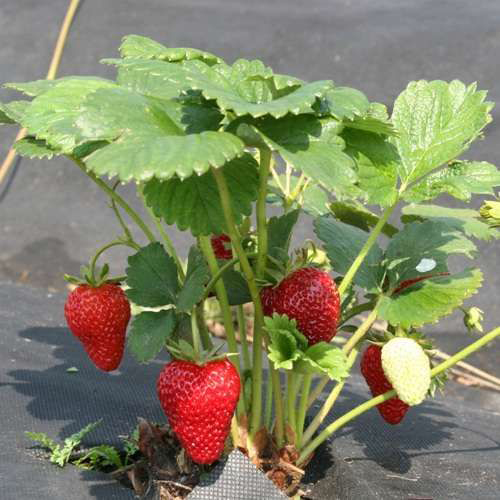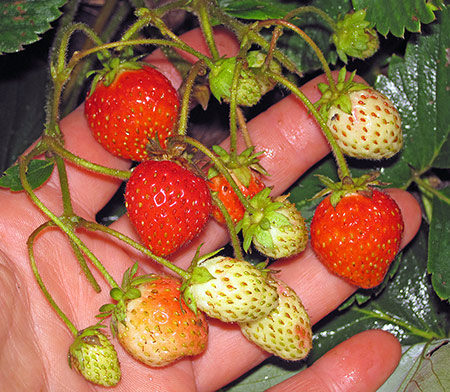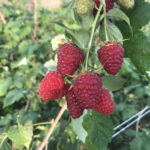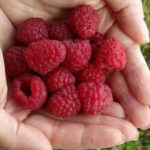Strawberry variety Garland
Garland is a remontant variety of garden strawberries (strawberries) for dessert use. It was bred in the Moscow region by the specialists of Agrofirma Poisk LLC, and is positioned as one of the best remontants of the Russian selection. In 2012, 5 years after filing an application for registration and passing state tests, the variety was included in the State Register of Plants of the Russian Federation. Approved for cultivation in all regions of Russia, according to gardeners' reviews, strawberries feel equally well in a wide variety of climatic conditions. The garland is suitable for cultivation in open and protected ground, in tunnels and greenhouses, as well as in containers, it can also be used in an ampelous version.

The plant is quite powerful, medium-sized, up to 25 cm high, medium-leafy, spherical in shape. The mustache of the variety is of medium length, green with a pinkish tint, formed in moderate quantities. Leaves are medium-sized, medium-silvery, concave, smooth, with strong pubescence, green with a blue tint. The denticles of the edges of the leaf plate are obtuse. The middle lobe of the leaf has an oval-rhombic shape. The petiole of the middle lobe is longer than the lateral ones. The petiole is of medium length. The stipules are pink. Strawberry flowers are medium in size, untwisted, bisexual, colored white. Inflorescences are multi-flowered, spreading. Peduncles are long, numerous, bear a large number of ovaries, are located at the level of leaves, and lie on the ground under the weight of the harvest.
Garland's berries are beautiful, medium and large in size, with a regular wide-conical shape, without a neck, rather uniform in the total mass, although by the end of the season they acquire more elongated shapes. The skin is bright red, shiny. Achenes yellow, shallowly depressed. Strawberry pulp is light red, juicy, tender, aromatic. The taste of the variety is excellent, the berries have a very pleasant dessert taste with a strawberry hue, sweet with useful sourness, with a delicate texture. Tasting assessment of fresh fruits, according to the State Register of Breeding Achievements of the Russian Federation, was 4.1 points out of five.
Berries are versatile in use, suitable for processing, but they are best suited for fresh consumption. Due to the rather delicate pulp, the fruits do not tolerate transportation and storage, so the Garland is not recommended for growing for commercial purposes, but for a garden plot it is very good. But it is worth saying that the gardeners did not particularly appreciate our heroine, in particular in terms of taste - an ordinary strawberry, no frills and "zest".
The average weight of fruits in the season, according to the State Register of Plants of the Russian Federation, fluctuates between 26−32 grams, fruiting is stable, the berries are not inclined to become too shallow by the end of the season, but this trend can still be traced, especially with not too good care. In general, the variety does not belong to the group of intensive ones, it does not need to create ideal growing conditions, but nevertheless, literacy of agricultural technology directly affects its productivity and quality of berries. Garland's yield is high, according to the State Register, up to 616 kg / ha, or about 1 kg of fruit per bush. In garden conditions, such results are not always achievable, again, the whole point is in the intensity of agricultural technology.

Strawberries have a fairly good immunity, they are not affected by diseases more often than other varieties on the site, but there is one unpleasant nuance - in especially rainy seasons, the susceptibility of plants to fungal diseases increases, so during such periods one should be very careful about preventive treatments. In general, our heroine has earned the title of "extremely tenacious", according to gardeners, she can grow, so to speak, on her own, without leaving at all, while feeling quite comfortable.Of course, such an extreme will not lead to good yields, so you should still take at least minimal care of your plantings.
According to the State Register of Varieties of the Russian Federation, Garland has an average drought resistance and winter hardiness. According to gardeners, strawberries feel great in various climatic latitudes, winters very well in Central Russia, without attacks, in more northern regions it is still advisable to take care of a good shelter. As for dry periods, plants tolerate them persistently, however, yields may suffer, so you should still not forget about watering. On the other hand, as already mentioned, our heroine is very "tenacious" and will take agrotechnical mistakes quite calmly, unlike many foreign repairmen, for whom imperfect care can be fatal, especially in many regions of Russia.
In agricultural technology, the Garland is extremely simple and undemanding, it can be classified as a "strawberry for the lazy", it is great for those gardeners who do not have the opportunity to often visit their site. According to the originator, the variety can grow on any soils, but it shows the best results on light and medium-textured soils with an acidity of pH 5.0-6.5. And, of course, the main point that has a significant impact on the yield and taste of berries is soil fertility. Do not skimp on fertilization before planting plants, and also do not forget to fertilize during their growing season as needed. Otherwise, caring for our heroine is pretty standard and does not differ in any peculiarities. The only caveat - do not neglect the timely rejuvenation of the plantation, the strawberry is remontant, it quickly develops its full potential, therefore, the renewal of the planting material must be done at least once every 3 years, with intensive use it may be needed within a year.

The garland is positioned as one of the best ampelous varieties, the bushes, according to the originator, have a high decorative effect. If we look at these characteristics more realistically, we can say the following. In general, almost all remontants are suitable for growing in an ampelous version, since they can bear fruit on unrooted sockets of the current year (this is the parameter that is considered one of the main ones for the "curly" varieties). What is so surprising about our heroine is a rather interesting question. In order not to be unfounded, we will give an example of an alternative - strawberry Elan F1... Currently, he is considered one of the best foreign remontants, suitable for growing in the ampelous version.
There is another interesting point. The garland is touted as the best remontant variety with very high yields and excellent taste. But is it really so? Gardeners did not see in our heroine something that would allow her to claim leadership among remontants of foreign selection. If we consider domestic varieties, then, of course, this strawberry can be put on the list of favorites. But if we put aside the prejudices that Russian varieties are tastier than overseas varieties, we can say the following. In principle, thanks to her good adaptability to the climatic conditions of the regions of Russia, our heroine can noticeably beat popular foreign varieties both in yield and in taste. But positioning it as the best of the best is controversial and just looks like overly loud ads. Even at the time of its appearance on the market, the assortment already had worthy competitors, bypassing the Garland in many ways, and now it clearly cannot be called the best against the background of newfangled varieties with really "crazy" yield and good taste. And if we take into account the insufficiently dense pulp of our heroine's berries, then we can even say that she has never been and never will be the best, commercially, of course.
What I would like to say at the end. The garland is a very good strawberry that clearly deserves your attention.We will not list its advantages and disadvantages again, but draw a small conclusion. Our heroine may well compete with foreign favorites of the range of repairmen, but only within the suburban area. Against the background of solid varieties, it looks more advantageous for gardeners, but for farmers it is not so attractive. But the reviews of gardeners are not entirely rosy. Yes, it is a high-yielding variety, quite tasty, but, so to speak, common. Currently, with an abundance of choice, gardeners want something more interesting. In general, Garland is a reliable and stable workhorse, ready to provide you with a harvest even in problematic climatic conditions, which other varieties, especially foreign ones, are hardly capable of.









Exactly. Exactly the same as in the photo. I planted in the spring both in the ground and in a container. Peas, but tasty. Somehow it doesn't smell like large-fruited. Maybe next year he will give out genetics. But for now, alas! I'll wait another year. Otherwise, the opposite is true regarding the description of the variety. And Elizabeth filled up with berries.
I waited three years from a garland of berries. One disappointment. Peas and no more, although with the taste of strawberries, if not too lazy to collect. I will remove it like a weed, it does not deserve another name. Complete divorce.
Strawberry "Garland" was not impressed. The berries are large, there are many of them. But the stems are weak, lie on the ground, and if the weather is damp, the berries quickly grow moldy, the leaves are covered with powdery mildew. But I liked the sort of remontant strawberry "Ruyana". The berries, although not so large, are not affected by anything, they hold well on the shoots and even in dry years there is a good harvest.
Rujana strawberries are a representative of the Czech family of remontant strawberries. Ruyana is an alpine strawberry, it has nothing to do with large-fruited garden strawberry (Strawberry). It retains the qualities of wild plants, therefore it has strong immunity and resistance to diseases.
This strawberry was propagated from ten bushes. The first year - two years, I managed to bear fruit only twice per season, and then - the second time the harvest was insignificant. In the fourth year, I transplanted to another place in the spring by dividing the bush, and in the fall she surprised me with both the harvest and the size of the berries. In the same year, the first snow fell early - in early October and melted quickly, but the berries were not damaged at all, and we managed to collect the rest of the crop again. Moreover, cold weather does not affect the taste - the berry does not become sour, it seems to me that in general all sourness disappears. Of the shortcomings - the berry lies mainly on the ground, therefore it is affected by diseases. I put cut grass under the bushes. Also, the berry bush grows old quickly - the middle dies out. In my experience - it is better to propagate by dividing the bush, and not by layering - it will begin to bear fruit faster.
I disagree with your opinion. I liked the garland. My birthday is on the third of June, and for this day I always have my own strawberries on my table, and large ones, since the first one. It bears fruit all summer and autumn, until the very frost, but at the same time it is necessary to cut off the dry leaves in time and do not forget to feed. Yes, one more thing, I grow strawberries strictly on covering material, one year did not grow and half of the harvest was lost.It doesn’t cost much, it’s enough for me for two years, but your strawberry will be grateful to you. She is always clean. Even if the summer is rainy, your harvest will not be lost and the berries will not grow moldy.